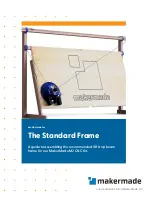
10
NI
IE
storage period (two LED lights on the
charge status display (3) illuminate).
• During a longer storage period, check
the state of charge of the battery and
recharge if necessary roughly every
3 months.
• In order to keep the battery well
charged, avoid exposing the appliance
to extreme heat or cold in storage.
• Store the equipment between 10 °C
and 25 °C. During storage, avoid ex-
treme cold or heat so the battery does
not lose power.
Wall mounted charger
(optional)
You can also mount the charger (5) on the
wall.
• Using dowels, place two screws hori
-
zontally 152.4 mm (6”) apart at the
desired position on a wall.
• The screw head can have a diameter
of 7 - 10 mm.
• Leave the screw heads protruding at
a distance of approx. 10 mm from the
wall.
• With the openings of the wall bracket,
you can attach the charger (5) to the
two screws and pull the charger down
until it stops.
When drilling, be careful not to
damage any supply lines. Use
suitable search devices to find
these or consult an installation
plan for guidance. Contact with
electrical cables can lead to
electric shock and fire. Contact
with a gas pipe can result in
an explosion. Damage to a
water pipe can lead to proper-
ty damage and electric shock.
Cleaning
Clean the rechargeable battery (1) and
charger (5) with a dry brush or dry cloth.
Keep the rechargeable battery (1) and
charger (5) away from moisture and sharp
objects.
Maintenance
• The equipment is maintenance free.
Disposal/environmental
protection
Remove the battery from the device and
take the device, battery, accessories and
packaging for environmentally friendly
recycling.
Electric units do not belong with do
-
mestic waste.
Do not dispose of batteries in house
-
hold waste, fire (risk of explosion) or
water. Damaged batteries may dam
-
age the environment and your health
if toxic fumes or liquids leak out.
• Return the unit and the recharger to a
recycling centre. The plastic and metal
parts employed can be separated out
and thus recycled use can be imple
-
mented. Ask our Service-Center for
details.
• Dispose of batteries in discharged condi
-
tion. We recommend covering the pole
with adhesive tape to prevent a short
circuit. Do not open up the battery.
• Dispose of batteries in accordance with
the local regulations. Take batteries to an
old battery collection point where they
will be recycled in an environmentally
friendly manner. For information about
Содержание PKGA 40-Li A1
Страница 3: ...3 A 1 11 12 13 14 17 16 15 2 2 18 21 22 23 24 28 29 30 31 27 25 26 20 19 2 3 4 5 6 8 7 9 10 ...
Страница 4: ...4 E D 2 4 33 39 42 40 41 34 38 62 4 32 3 1 23 35 36 44 43 45 37 8 7 5 B C 23 21 ...
Страница 68: ...68 20190311_rev02_sh Exploded Drawing Explosionszeichnung PKGA 40 Li A1 informative informativ ...
Страница 69: ...46 6 4 48 47 20 9 22 24 14 50 51 49 2 57 57 58 59 59 17 21 ...
Страница 70: ...14 17 22 52 53 53 15 14 63 56 60 61 61 54 55 52 22 14 23 Rope Winding 64 65 ...
Страница 71: ......
Страница 75: ...1 2 3 4 5 5 4 6 4 ...
Страница 95: ...23 ...
















































